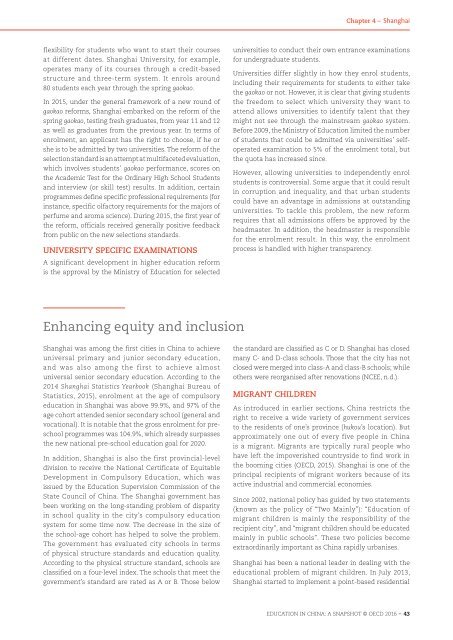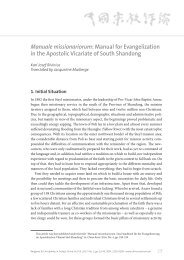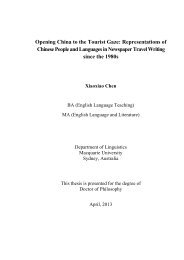EDUCATION IN CHINA
Education-in-China-a-snapshot
Education-in-China-a-snapshot
You also want an ePaper? Increase the reach of your titles
YUMPU automatically turns print PDFs into web optimized ePapers that Google loves.
Chapter 4 – Shanghai<br />
flexibility for students who want to start their courses<br />
at different dates. Shanghai University, for example,<br />
operates many of its courses through a credit-based<br />
structure and three-term system. It enrols around<br />
80 students each year through the spring gaokao.<br />
In 2015, under the general framework of a new round of<br />
gaokao reforms, Shanghai embarked on the reform of the<br />
spring gaokao, testing fresh graduates, from year 11 and 12<br />
as well as graduates from the previous year. In terms of<br />
enrolment, an applicant has the right to choose, if he or<br />
she is to be admitted by two universities. The reform of the<br />
selection standard is an attempt at multifaceted evaluation,<br />
which involves students’ gaokao performance, scores on<br />
the Academic Test for the Ordinary High School Students<br />
and interview (or skill test) results. In addition, certain<br />
programmes define specific professional requirements (for<br />
instance, specific olfactory requirements for the majors of<br />
perfume and aroma science). During 2015, the first year of<br />
the reform, officials received generally positive feedback<br />
from public on the new selections standards.<br />
UNIVERSITY SPECIFIC EXAM<strong>IN</strong>ATIONS<br />
A significant development in higher education reform<br />
is the approval by the Ministry of Education for selected<br />
universities to conduct their own entrance examinations<br />
for undergraduate students.<br />
Universities differ slightly in how they enrol students,<br />
including their requirements for students to either take<br />
the gaokao or not. However, it is clear that giving students<br />
the freedom to select which university they want to<br />
attend allows universities to identify talent that they<br />
might not see through the mainstream gaokao system.<br />
Before 2009, the Ministry of Education limited the number<br />
of students that could be admitted via universities’ selfoperated<br />
examination to 5% of the enrolment total, but<br />
the quota has increased since.<br />
However, allowing universities to independently enrol<br />
students is controversial. Some argue that it could result<br />
in corruption and inequality, and that urban students<br />
could have an advantage in admissions at outstanding<br />
universities. To tackle this problem, the new reform<br />
requires that all admissions offers be approved by the<br />
headmaster. In addition, the headmaster is responsible<br />
for the enrolment result. In this way, the enrolment<br />
process is handled with higher transparency.<br />
Enhancing equity and inclusion<br />
Shanghai was among the first cities in China to achieve<br />
universal primary and junior secondary education,<br />
and was also among the first to achieve almost<br />
universal senior secondary education. According to the<br />
2014 Shanghai Statistics Yearbook (Shanghai Bureau of<br />
Statistics, 2015), enrolment at the age of compulsory<br />
education in Shanghai was above 99.9%, and 97% of the<br />
age cohort attended senior secondary school (general and<br />
vocational). It is notable that the gross enrolment for preschool<br />
programmes was 104.9%, which already surpasses<br />
the new national pre-school education goal for 2020.<br />
In addition, Shanghai is also the first provincial-level<br />
division to receive the National Certificate of Equitable<br />
Development in Compulsory Education, which was<br />
issued by the Education Supervision Commission of the<br />
State Council of China. The Shanghai government has<br />
been working on the long-standing problem of disparity<br />
in school quality in the city’s compulsory education<br />
system for some time now. The decrease in the size of<br />
the school-age cohort has helped to solve the problem.<br />
The government has evaluated city schools in terms<br />
of physical structure standards and education quality.<br />
According to the physical structure standard, schools are<br />
classified on a four-level index. The schools that meet the<br />
government’s standard are rated as A or B. Those below<br />
the standard are classified as C or D. Shanghai has closed<br />
many C- and D-class schools. Those that the city has not<br />
closed were merged into class-A and class-B schools; while<br />
others were reorganised after renovations (NCEE, n.d.).<br />
MIGRANT CHILDREN<br />
As introduced in earlier sections, China restricts the<br />
right to receive a wide variety of government services<br />
to the residents of one’s province (hukou’s location). But<br />
approximately one out of every five people in China<br />
is a migrant. Migrants are typically rural people who<br />
have left the impoverished countryside to find work in<br />
the booming cities (OECD, 2015). Shanghai is one of the<br />
principal recipients of migrant workers because of its<br />
active industrial and commercial economies.<br />
Since 2002, national policy has guided by two statements<br />
(known as the policy of “Two Mainly”): “Education of<br />
migrant children is mainly the responsibility of the<br />
recipient city”, and “migrant children should be educated<br />
mainly in public schools”. These two policies become<br />
extraordinarily important as China rapidly urbanises.<br />
Shanghai has been a national leader in dealing with the<br />
educational problem of migrant children. In July 2013,<br />
Shanghai started to implement a point-based residential<br />
<strong>EDUCATION</strong> <strong>IN</strong> CH<strong>IN</strong>A: A SNAPSHOT © OECD 2016 – 43





